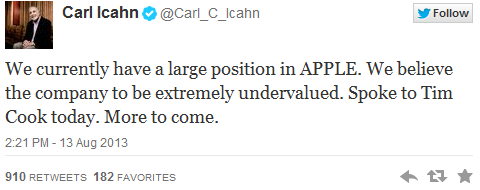 Behind every “old wives’ tale” there has to be a kernel of truth. That’s part of the basis for it being handed down from one generation to the next.
Behind every “old wives’ tale” there has to be a kernel of truth. That’s part of the basis for it being handed down from one generation to the next.
While I don’t necessarily believe that the souls of dead children reside in toads or frogs, who knows? The Pets.com sock puppet was real enough for people to believe in it for a while. No one got hurt holding onto that belief.
The old saw “Sell in May and go away,” has its origins in a simpler time. Back when The Catskills were the Hamptons and international crises didn’t occur in regular doses. There wasn’t much reason to leave your money in the stock market and watch its value predictably erode under the hot summer sun back in the old days.
Lately, some of those old wives’ tales have lost their luster, but the Summer of 2013 has been pretty much like the old days. With only a bare minimum of economic news and that part of the world that could impact upon our stock market taking a summer break, it has been an idyllic kind of season. In fact, with the market essentially flat from Memorial Day to Labor Day it was an ideal time to sell covered options.
So you would think that Syria could have at least waited just another week until the official end to the summer season, before releasing chemical weapons on its own citizens and crossing that “red line,” that apparently has meaning other than when sunburn begins and ends.
Or does it?
On Monday, Secretary of State John Kerry made it clear where the United States believed that blame lay. He used a kind of passion and emotion that was completely absent during his own Presidential campaign. Had he found that tone back in 2004 he might be among that small cadre of “President Emeritus” members today. On Friday he did more of the same and sought to remove uncertainty from the equation.
Strangely, while Kerry’s initial words and intent earlier in the week seemed to have been very clear, the market, which so often snaps to judgment and had been in abeyance awaiting his delayed presentation, didn’t know what to do for nearly 15 minutes. In fact, there was a slightly positive reaction at first and then someone realized the potentially market adverse meaning of armed intervention.
Finally, someone came to the realization that any form of warfare may not be a market positive. Although selling only lasted a single day, attempts to rally the markets subsequently all faded into the close as a variant on another old saying – “don’t stay long going into the weekend,” seemed to be at play.
That’s especially true during a long weekend and then even more true if it’s a long weekend filled with uncertainty. As it becomes less clear what our response will be, paradoxically that uncertainty has led to some calm. But at some point you can be assured that there will be a chorus of those questioning President Obama’s judgment and subsequent actions and wondering “what would Steve Jobs have done.”
John Kerry helped to somewhat answer that question on Friday afternoon and the market ultimately settled on interpreting the message as being calming, even though the message implied forceful action. What was clear in watching the tape is that algorithms were not in agreement over the meaning of the word “heinous.”
With the market having largely gone higher for the past 20 months the old saying seeking to protect against uncertainty during market closures has been largely ignored during that time.
But now with uncertainty back in the air and the summer season having come to its expected end, it is back to business as usual.
That means that fundamentals, such as the way in which earnings have ruled the market this past summer take a back seat to “events du jour” and the avalanche of economic reports whose relevance is often measured in nano-seconds and readily supplanted by the next bit of information to have its embargo lifted.
This coming week is one of great uncertainty. I made fewer than the usual number of trades last week and if i was the kind that would be prone to expressing regret over some of them, I would do so. I expect to be even more cautious this week, unless there is meaningful clarity introduced into the equation. While wishing for business as usual, that may not be enough for it to become reality.
As usual, the week’s potential stock selections are classified as being in Traditional, Double Dip Dividend and , Momentum categories, with no suitable “PEE” selections this week (see details).
While I currently own more expensive shares of Caterpillar (CAT), I almost always feel as if it’s a good time to add shares. Caterpillar has become everyone’s favorite stock to disparage, reaching its peak with famed short seller Jim Chanos’ presentation at the “Delivering Alpha Conference” a few weeks ago. as long as it continues trading in a $80-$90 range it is a wonderful stock for a covered call writing strategy and it has reliably stayed in that range.
Joy Global (JOY) reported its earnings last week and beat analysts estimates and reaffirmed its 2014 guidance. Nonetheless it was brutalized in the aftermath. Although already owning shares I took the opportunity to sell weekly put options in the belief that the reaction was well overdone.
If the reports of an improving Chinese economy are to be believed, and that may be a real test of faith, then Joy Global stands to do well. Like Caterpillar, it has traded in a reasonably narrow range and is especially attractive in the $48-53 neighborhood.
eBay (EBAY) is simply on sale, closing the week just below the $50 level. With no news to detract from its sh
are price and having traded very well in the $50 -53 range, it’s hard to justify why it fell along with other stocks in the uncertainty that attended the concerns over Syria. It’s certainly hard to draw a straight line from Syria related fears to diminished earnings at eBay.
By the recent measure that I have been using, that is the comparison to the S&P 500 performance since May 21, 2013, the market top that preceded a small post-Ben Bernanke induced correction, eBay has well underperformed the index and may be relatively immune from short term market pressure.
Baxter International (BAX) is one of those stocks that I like to own and am sad to see get assigned away from me. Every job has its negative side and while most of the time I’m happy seeing shares assigned, sometimes when it takes too long for them to return to a reasonable price, I get forlorn. In this case, timing is very serendipitous, because Baxter has fallen in price and goes ex-dividend this week.
Coach (COH) also goes ex-dividend this week and that increases its appeal. At a time when retail has been sending very mixed messages, and at a time when Coach’s position at the luxury end is being questioned as Michael Kors (KORS) is everyone’s new darling, COach is yet another example of a stock that trades very well in a specific range and has been very well suited to covered option portfolios.
In general, I’ve picked the wrong year to be bullish on metals and some of my patience is beginning to wear thin, but I’ve been seeing signs of some stability recently, although once again, the risk of putting too much faith into a Chinese recovery may carry a steep price. BHP Billiton (BHP) is the behemoth that all others bow to and may soon receive the same kind of fear and respect from the potash industry, as it is a prime reason the cartel has lost some of its integrity. BHP Billiton also goes ex-dividend this week and is now about 6% below its recent price spurt higher.
Seagate Technology (STX) isn’t necessarily for the faint of heart. but it is down nearly 20% from its recent high, at a time when there is re-affirmation that the personal computer won’t be disappearing anytime soon. While many of the stocks on my radar screen this week have demonstrated strength within trading ranges, Seagate can’t necessarily lay claim to the same ability and you do have to be mindful of paroxysms of movement which could take shares down to the $32 level.
While Seagate Technology may offer the thrills that some people need and the reward that some people want, Walgreen (WAG) may be a happy compromise. A low beta stock with an option premium that is rewarding enough for most. Although Walgreen has only slightly under-performed the S&P 500 since May 21st, I think it’s a good choice now, given potential immunity from the specific extrinsic issues at hand, particularly if you are under-invested in the healthcare sector.
Another area in which I’m under-invested is in the Finance sector. While it hasn’t under-performed the S&P 500 recently, Bank of New York Mellon (BK) is still about 7% lower in the past 5 weeks and offers a little less of a thrill in ownership than some of my other favorites, JP Morgan Chase (JPM) and Morgan Stanley (MS). Sometimes, it’s alright giving up on the thrills, particularly in return for a competitive option premium and the ability to sleep a bit sounder at night.
Finally, with the excitement about Steve Ballmer finally leaving Microsoft (MSFT) after what seems like an eternity of such calls, the share price has simply returned to a more inviting re-entry levels. In fact, when Ballmer announced his decision to leave the CEO position in 12 months, I did something that I rarely do. I bought back my call options at a loss and then sold shares at the enhanced share price. Occasionally you see a shares appreciation outstrip the appreciation in the in the money premium and opportunities are created to take advantage of the excitement not being reflected in future price expectations.
At the post-Ballmer excitement stage there is still reason to consider share ownership, including the anticipation of another dividend increase and option premiums while awaiting assignment of shares
Traditional Stocks: Bank of New York Mellon, Caterpillar, eBay, Microsoft, Walgreen
Momentum Stocks: Joy Global, Seagate Technology
Double Dip Dividend: Baxter International (ex-div 9/4), BHP Billiton (ex-div 9/4), Coach (ex-div 9/5)
Premiums Enhanced by Earnings: none
Remember, these are just guidelines for the coming week. The above selections may be become actionable, most often coupling a share purchase with call option sales or the sale of covered put contracts, in adjustment to and consideration of market movements. The over-riding objective is to create a healthy income stream for the week with reduction of trading risk.

 I received a very nice text message from a subscriber this morning.
I received a very nice text message from a subscriber this morning.





 I believe, although I could be mistaken, that an original version of the Bible suggested that “an octogenarian shall lead them.”
I believe, although I could be mistaken, that an original version of the Bible suggested that “an octogenarian shall lead them.”



 To summarize: The New York Post rumors, “The Dark SIde” and the FOMC.
To summarize: The New York Post rumors, “The Dark SIde” and the FOMC.